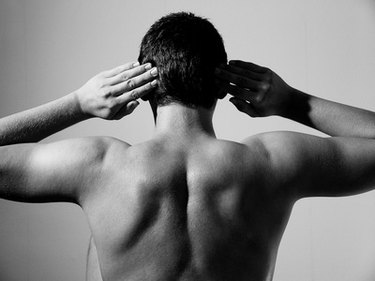
Pronated and supinated pull-ups are excellent exercises that target the upper body for muscle growth. Pronation and supination refer the the positioning of your hands during the pull-up exercise. By changing your grip, you shift the focus on the muscles and even the type of training stimulus being supplied.
Definitions
Video of the Day
Doing pull-ups with a pronated grip means that your palms face away from your body as you do the exercise. To do these correctly, drive your elbows down and back as you pull your body up toward the pull-up bar. Many make the mistake of stopping when their chin reaches a point above the bar. According to "3-D Muscle-Building" authors Jonathan Lawson and Steve Holman, focus on pulling your chest toward the bar for a full back contraction at the top. Supinated-grip pull-ups are done with your palms facing your body, like a curl grip used when doing bicep curls. Drive your elbows back and out as you pull your body up for a full back contraction.
Video of the Day
Significance
The significance of the grip used while doing pull-ups is the part of the back that the exercise targets and the kind of force it applies to those muscle fibers. The pronated grip creates what Lawson and Holman call a max force, midrange stimulus on the back muscles, primarily targeting the latissimus dorsi and rhomboids. This type of exercise should come first in your workout because it engages more muscle fibers than isolation-oriented training. Supinating your grip puts more of an isolation or contracted-position stimulus on the back. This undergrip form is best for finishing off a back workout.
Effects
Pronated pull-ups target the rhomboids and latissimus dorsi for muscle growth in an eight to 12 repetition range, according to "3-D Muscle-Building." This grip also places stress on the forearms, shoulders and biceps as stabilizers. Supinating the grip moves the emphasis onto the biceps. In fact, by keeping your forearms perpendicular to the ground, you can directly target the biceps. For this specific training emphasis, stop the exercise's lowering phase when your upper arms reach parallel to ground or just below. When performing supinated pull-ups for the back, fully contract each rep by squeezing the elbows back and outward.
Uses
Pronated and supinated pull-ups both make excellent compound exercises for the whole upper body. According to "Combat the Fat" author Jeff Anderson, body weight exercises such as pull-ups have a unique muscle-growth stimulus on the central nervous system due to the fact that you must balance and stabilize your body against gravity. You can use pronated pull-ups as your primary compound movement for developing back width, adding resistance by hanging weighted plates from a dipping belt. Supinated pull-ups can be used either as an isolation movement for the back muscles or as a compound mass movement for the biceps.
Considerations
Varying your grip changes the emphasis on the muscles targeted with pronated and supinated pull-ups. For example, either exercise can be performed with the hands positioned at varying distances from each other on the pull-up bar. Trainees may choose to use a close grip, a very wide grip or anything in between these. "3-D Muscle Building" authors Lawson and Holman recommend the in-for-out and out-for-in method of determining your pull-up grip. To target the middle of the back, you take a wider grip on the bar. For emphasis on the width of the back, you take a closer grip. Pull-up bar grips can further be diversified by choosing a thumb-in or thumb-out grip. Beginning trainees should always wrap their thumbs around the bar for safety. However, leaving the thumb out of your grip may help to shift emphasis off of the biceps while doing pronated and supinated pull-ups for the back muscles.